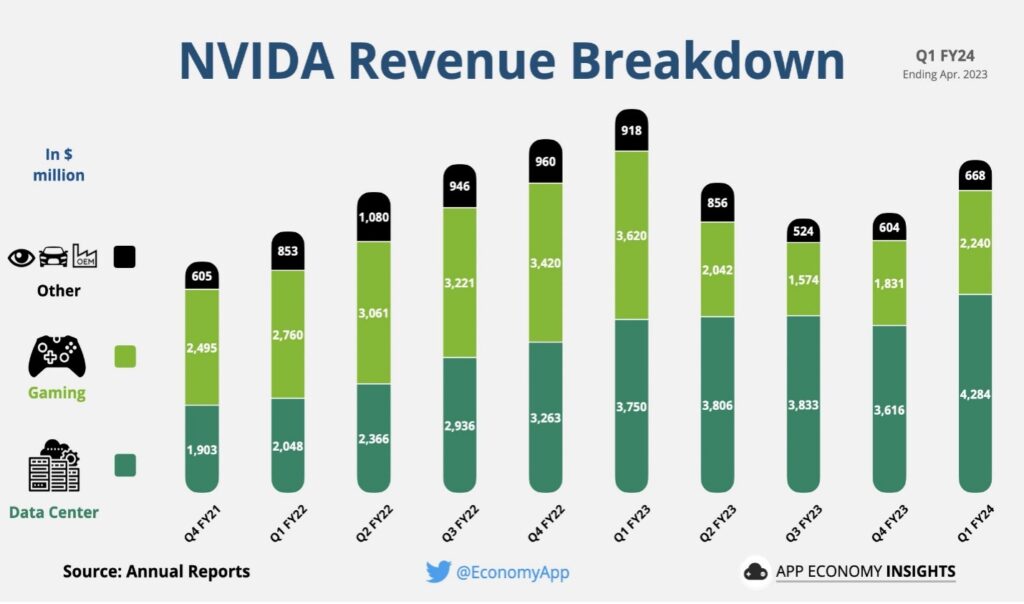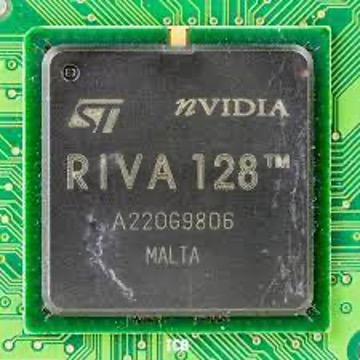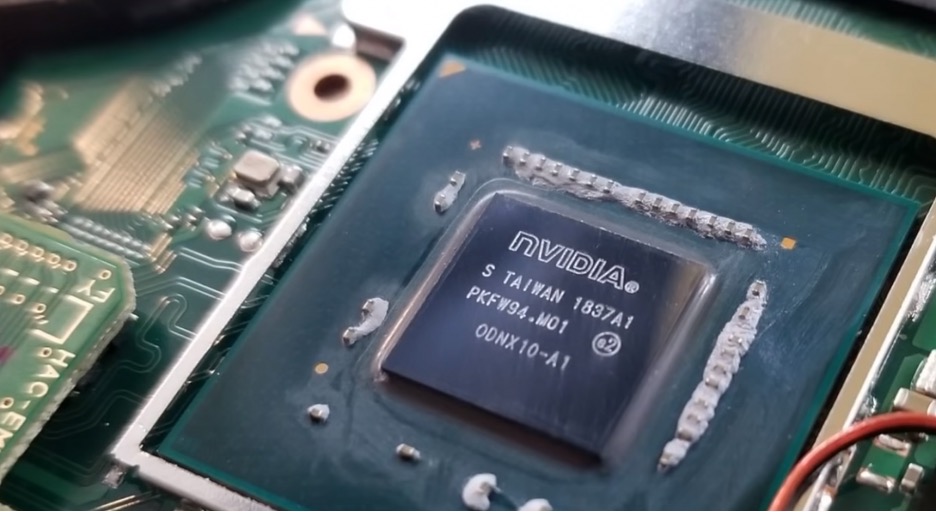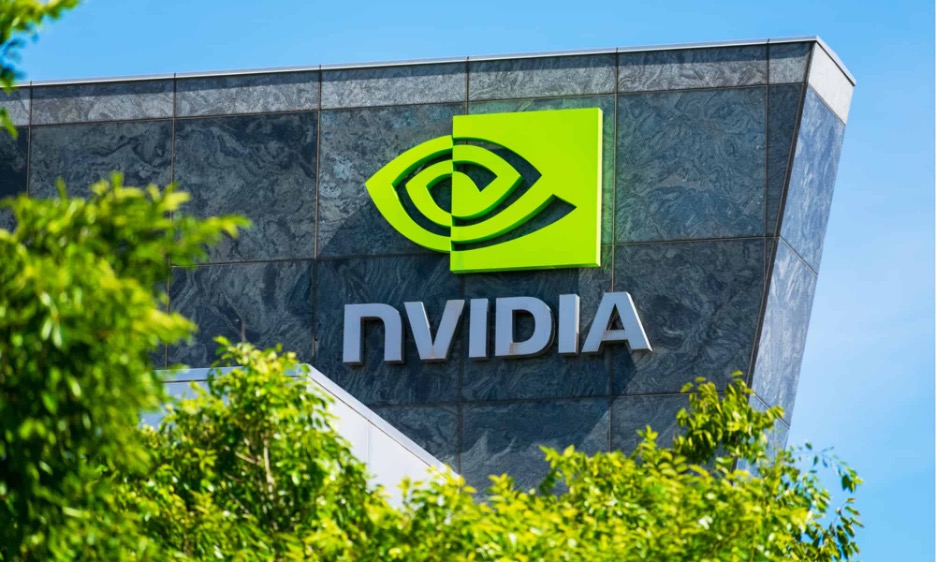NVIDIA is a prominent technology company known for its specialized graphics processing units and related hardware and software products. Founded in 1993, NVIDIA has become a leading player in the field of visual computing and artificial intelligence. NVIDIA’s GPUs are used across many industries, including gaming, professional visualization, data centers, and automotive applications. They are designed to handle complex calculations and render high-quality graphics, making them essential components in gaming consoles, personal computers, and workstations.
In addition to GPUs, NVIDIA has developed other products and technologies such as system-on-a-chip (SoC) solutions, deep learning accelerators, and software platforms for AI and machine learning applications. The company’s AI-focused hardware and software offerings cater to fields like autonomous vehicles, robotics, healthcare, and data analytics.
“What NVIDIA is to AI is almost like what Intel was to PCs,” Dan Hutcheson, an analyst at TechInsights. True as it is, today NVIDIA is where it is due to it’s early investment in AI.

When the company was first established in 1993, Jensen Huang, who is currently the CEO of NVIDIA, concentrated on improving graphics for games and other applications. They created GPUs in 1999 to enhance computer image display.
However, it was in 2006 when researchers at Stanford University discovered GPUs’ potential for accelerating math operations, surpassing regular processing chips. This pivotal moment led Mr. Huang to invest NVIDIA’s resources in making GPUs programmable, expanding their parallel processing capabilities beyond graphics. The company’s AI journey began when it added CUDA, a computing architecture, to its GPUs. This revolutionized the potential of what the chips could do by allowing software developers to tinker with the hardware. As this revelation spread among computer scientists, GPUs became sought-after for running this new type of workload, marking a significant leap in modern AI development. NVIDIA invested in creating new variants of GPUs which would be better suited to AI, as well as more software to make it easy to use the technology. In 2012, the unveiling of Alexnet, an AI image classifier, trained on just two of NVIDIA’s programmable GPUs, revolutionized the field. The training process, which previously took months on traditional chips, now only required a few days.
After almost a decade and many billions of dollars, ChatGPT—an AI that can provide uncannily human responses to queries—emerged. $100 million was spent on the 10,000 chips that were utilized to train ChatGPT. The total cost can be estimated by multiplying the number of chips by the cost per chip ($10,000 per chip). In Q1 2023, the company’s AI chip business grew by 14%, AMD did not grow and Intel’s business division decreased by 39%.

The company’s contribution to the gaming sector cannot be overlooked. NVIDIA has left an indelible mark on the world of graphics processing with its groundbreaking innovations and strategic partnerships.
In 1994, the company entered into a significant collaboration with SGS-Thompson, a semiconductor manufacturer, to provide manufacturing capacity and co-market the RIVA128ZX graphics processor. This partnership set the stage for NVIDIA’s future success.
In 1995, NVIDIA made its debut with the NV1 product, a PC card sold as the Diamond Edge 3D. This card featured a 2D/3D graphics core based on quadratic textured mapping. A notable achievement during this time was NVIDIA’s collaboration with Sega, a renowned arcade game company, to make Virtual Fighter the first 3D game to run on NVIDIA graphics. NVIDIA’s drive for innovation continued in 1996 when they unveiled their first Microsoft DirectX drivers with support for Direct3D. Direct3D is an application programming interface (API) used to render 3D graphics, emphasizing performance. NVIDIA’s commitment to DirectX technology proved instrumental, as DirectX became a standard in Windows operating systems.
The year 1997 marked another milestone with the launch of Riva 128, the world’s first 128-bit 3D processor. With support from SGS-Thompson, this product gained OEM acceptance, and over one million units were shipped within the first four months. NVIDIA was rapidly gaining popularity in the industry. Recognizing NVIDIA’s potential, 1998 saw the company establish a multi-year strategic partnership with Taiwan Semiconductor Manufacturing Company for manufacturing assistance. This collaboration bolstered NVIDIA’s production capabilities. The same year, NVIDIA introduced RIVA TNT, the first multi-textured 3D processor, further solidifying its reputation as an industry leader.

In 1999, NVIDIA made significant strides in professional graphics with the introduction of the Quadro GPU. NVIDIA defined the GPU as a single-chip processor capable of processing a minimum of 10 million polygons per second, featuring integrated transform, lighting, triangle setup/clipping, and rendering engines.
The year 2000 brought forth the launch of GeForce2 Go, the world’s first notebook GPU. Additionally, NVIDIA acquired 3DFX, a graphics pioneer, and Microsoft chose NVIDIA to power the graphics for its first Xbox gaming console, solidifying NVIDIA’s position as a leading provider of graphics technology.
In 2001, NVIDIA entered the integrated graphics market with nForce, expanding its reach to a wider range of computer systems. The same year, NVIDIA became the fastest semiconductor company to reach $1 billion in revenue and was added to the S&P 500 index.
In 2003, NVIDIA expanded its portfolio by acquiring Media Q, a leader in graphics and multimedia technology for wireless applications. In 2006, they celebrated the sale of their 500 millionth graphics processor, showcasing their dominant presence in the market. Additionally, the successful acquisition of Hybrid Graphics bolstered their expertise in developing embedded 2D and 3D graphics software for handheld devices.
In 2008, they acquired AGEIA, a developer of gaming physics technology. Furthermore, a Tokyo-based tech company constructed Tsubame , the first supercomputer based on NVIDIA’s Tesla-GPU, a significant achievement in high-performance computing.
In 2009, NVIDIA made strides in collaboration with Google, as they worked together to launch Android on Tesla processors, expanding the capabilities of mobile devices.
2010 brought a momentous achievement for NVIDIA, as their technology powered China’s Tianhe-1A, the world’s fastest supercomputer at that time. In 2012, Oak Ridge National Laboratory introduced Titan, the world’s top supercomputer, powered by NVIDIA’s Kepler-based Tesla GPUs.
In 2014, NVIDIA made significant inroads in the Android gaming market with the release of Tegra K1, a shield tablet. They also unveiled Maxwell, their 10th generation architecture, which revolutionized GeForce GTX GPU performance, graphics, and efficiency.
The year 2015 marked NVIDIA’s foray into deep learning with the launch of Tegra X1, a drive, and the introduction of NVIDIA SHIELD, their first living room entertainment device, transforming the TV experience.

NVIDIA continued their streak of innovation in 2018 with the introduction of the Turing Architecture, powering the world’s first GPUs capable of real-time ray tracing. They also introduced RAPIDS, an open-source GPU-acceleration platform designed to expedite data science and machine learning.
In 2019, NVIDIA announced advancements across various sectors, including HPC, embedded systems, data centers, autonomous vehicles, and professional graphics, demonstrating their commitment to pushing the boundaries of technology.
Finally, in 2020, NVIDIA’s acquisition of Mellanox, a leader in high-performance interconnect technology, solidified their position in the HPC market and created a formidable force in the industry.
In 2022, Nvidia introduced Omniverse. NVIDIA Omniverse is a computing platform which allows users to collaborate and create Universal Scene Descriptions-based on 3D workflows and their applications.

Evidently, NVIDIA’s overnight success was in the making for a long time.
NVIDIA’s annual revenue for 2023 was $26.974B, a 0.22% increase from 2022 and the annual revenue for 2022 was $26.914B, a 61.4% increase from 2021.
With every company wanting to use AI, it looks like the AI race is being won by NVIDIA. The company has a stronghold on the market share for GPUs globally – a lead which is unlikely to wane in the near future. This year, the stock has returned more than 163% — a meteoric rise that led the chipmaker to touch a $1 trillion market capitalization.
Written by – Prithika Deb
Edited by – Zainab Kazi




